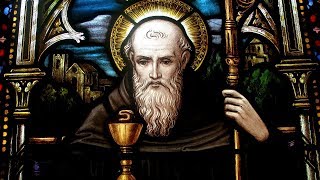Saint Benedict of Nursia (c. 480-547) holds a prominent place in the history of Christian monasticism, having greatly influenced its development. Our knowledge of St. Benedict primarily comes from the writings of Pope Saint Gregory I, who composed his Dialogues in the late 6th century. While lacking precise dates and featuring elements of folklore and legend, Gregory's account is generally considered to be factual.
Born into a noble Roman family, Benedict received early education in Nursia and later pursued further studies in Rome. After completing his education, he chose to abandon the luxurious lifestyle of the city and retreated to the countryside. Settling near modern Affile and the Abruzzi foothills, he embraced a hermit's life, earning renown for his miracles and deep piety.
Word of the hermit's reputation reached nearby monks, who implored Benedict to become their abbot. Eventually convinced, Benedict accepted their offer and assumed leadership of the monastery. However, his arrival brought about discontent among the monks, for he sought to revolutionize the existing monastic practices by instilling greater discipline and piety. This approach didn't sit well with the monks, many of whom were former nobles like Benedict, and they grew resentful of their new abbot's strict rules.
The discontent within the monastic community escalated into a treacherous plot against Benedict's life. According to ancient sources, the monks attempted to assassinate him in two ways. First, they allegedly tried to poison his bread, and then they attempted to poison his wine. Remarkably, the latter attempt was thwarted when, according to the tale, Benedict made the sign of the cross over the cup, causing it to shatter and spill its contents on the floor. Through divine intervention or cautious vigilance, Benedict survived the assassination attempts orchestrated by his ungrateful followers.
Upon discovering the malevolent intentions of the monks, Benedict chose to step down as abbot and return to his solitary life as a hermit. However, his retreat into isolation did not last long, as more disciples sought his wisdom and guidance. Convincing him to give monasticism another try, they became his followers, and he established twelve monasteries based on his Rule of St. Benedict. This rule, governing monastic life with its emphasis on prayer, work, and communal living, solidified his legacy as the father of Western monasticism.
Over time, Saint Benedict's influence extended beyond the confines of his monasteries and resonated across Europe. In recognition of his profound impact on the continent's spiritual and cultural heritage, Pope Paul VI declared him the patron saint of Europe in 1964, affirming his enduring significance in Christian history.

